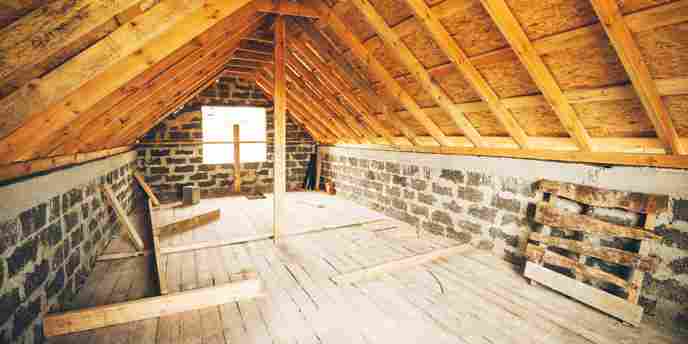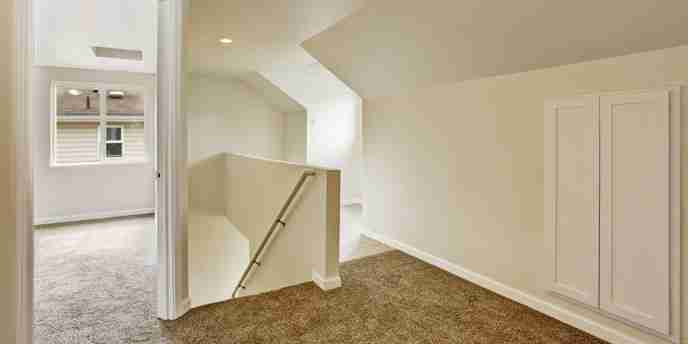There’s nothing like walking out of a summer heat wave and into the frigid comfort of air conditioning. But for some homes, especially those built before the 1950s, AC isn’t an option. So how do you keep a house cool in the summer without air conditioning?
The answer: summer-proof each floor, one by one.
Here are the 18 best ways to keep your house cool without AC, from top to bottom – starting with the attic.
How to Keep Your Home Cool Without Air Conditioning

Best Ways to Cool a House: In the Attic
1. Vent Your Attic
Attics take the brunt of the heat our homes face during the summer, according to Scott Trento of QuietCool Whole House Fans :

“Your attic is typically 20 to 30 degrees hotter than the rest of your home. If there’s not enough venting, it’s going to trap a lot of hot air which can heat up your entire home. Use an attic fan to improve ventilation.”
Scott Trento | QuietCool Whole House Fans
Attic fans are typically either gable or roof-mounted. “Roof-mounted fans are installed on the exterior of your roof, while gable-mounted fans are installed right onto your existing vents,” says Trento.
Installing gable mount fans is easy, as they are designed to attach to the existing vents of your attic. To install a roof mount attic fan, you’ll need to cut an opening for it – this is a little more work but it creates a tighter seal and stronger suction, which helps cool your attic more efficiently.
For a cooling solution that adjusts to the weather, you can opt for a Smart Attic Fan , which automatically changes fan speeds depending on the temperature inside your attic. “Plus, the Smart Attic Fan is great for DIYers because it’s mostly plug-and-play,” says Trento.
2. Insulate Attic Walls
Another way to keep your home cool in the summer is to insulate your attic from top to bottom. This will lower the amount of heat that enters your attic and prevent it from escaping to the rest of the home below.
3. Opt for a White Roof
On a sweltering day, traditional black roof materials can become over 100 degrees hotter than the air around them. A white roof can be a great way to keep your house cool in the summer because it reflects heat instead of absorbing it, keeping the warmth from seeping into the rest of your home.
You can install white roof panels or apply white roof coating if you have a flat or metal roof.

Best Ways to Cool a House: Upstairs
4. Place Box Fans in Windows
Like the attic, your upstairs tends to trap rising heat and using window box fans is a great way to keep a house cool in the summer naturally. When cooling a room with fans in windows, face them outward to vent the hot air out, especially when it’s hotter outside.
5. Invest in the Right Ceiling Fans
“One of the best ways to keep cool without AC is to install ceiling fans,” according to cooling expert Dan Nelson, senior director at Big Ass Fans .
“Anywhere people tend to congregate, whether it’s the bedroom, living room or kitchen, those are the spaces where you’re going to get the most benefit from a ceiling fan,” says Nelson.
But where the fans are installed is only the half of it; picking the right sized fan for your room is also important for effective cooling:
“Smaller rooms, around 15 feet by 15 feet or less don’t need anything larger than a 52-inch ceiling fan. For 20 feet by 20 feet rooms, we recommend a 60-inch fan. For larger rooms, 30 feet by 30 feet and above, you’re going to want an 84-inch fan.”
Dan Nelson | Big Ass Fans
New ceiling fans may be costly upfront but they are much less expensive than installing and using AC in the long run. “Ceiling fans are incredibly energy efficient, and our ENERGY STAR® Certified Haiku fans really stand out,” says Nelson. “If you run a Haiku fan non-stop for a year straight, you can expect to pay between $5 and $10 in electricity.”
Put to the same test, the most inefficient ceiling fans would cost around $120 per year, but even this is much cheaper than air conditioning. The cost to run central air can be as high as $120 per month – and that’s if you only run it six hours a day.
DC-powered fans, like the Haiku by Big Ass Fans (pictured), are cost-efficient and quiet, making them ideal for bedrooms.
Tips for Buying Ceiling Fans to Cool a Room:
6. Optimize the Fans You Have
If new fans aren’t in the budget, you can take steps to improve the ones you have.
Here are a few maintenance tips for cooling a room with fans more efficiently:
Run Fans Counter-Clockwise: In the summer, run your fans counter-clockwise on their highest setting to push air straight down and create a wind chill effect. In the winter, set them back to clockwise on low to slowly force warm air down into the room.
Clean Them Regularly: Keeping your ceiling fan dust-free isn’t just hygienic – it can also help your fan work better. Dirt on fans can heat up the motor, which can make them run more slowly.
Polish the Blades: Polishing a fan’s blades can reduce drag, improving its ability to move air. To do this, remove the blades and wipe them down with a damp cloth. Then, dry and coat them with a light furniture or metal polish, depending on the material of your blades. Let completely dry before reinstalling.
Fix Any Wobbling: If your fan is wobbling, it’s working a lot harder than it has to and won’t cool your room down well. Tighten or replace loose screws in your fan, including within the light fixture.
Oil Your Fan: Five to six drops of light machine oil can get rid of annoying squeaking sounds and help the motor run more efficiently. But know that not all fans can be oiled – some motors are completely sealed up. Look up your manufacturer’s guide for instructions on oiling your ceiling fan.
To keep cool while you sleep, use a pedestal fan or a BedJet (pictured) to push cool air into your bed.
7. Spot-Cool Your Bed
If you’re trying to figure out how to cool your bedroom with fans, focus your efforts on your bed. Use a pedestal fan to push cooler, middle-room air onto your bed while you sleep.
The climate-controlling BedJet fan uses the coolest air that sits on the floor of your room to help you stay cool under the covers on the hottest summer nights:
“The BedJet is designed to get rid of the main reason you’re feeling hot and stuffy in bed: body heat and moisture. It pulls air from the floor of your room which is typically a few degrees cooler than the temperature reading on your thermostat. It is really effective for keeping you cool in bed if your bedroom is 78 degrees and under.”
Sarah McClutchy | BedJet
8. Use Breathable Sheets
Breathable bedding is crucial to a cool night’s sleep. Silk or sateen sheets are light but tend to trap heat – stick to natural bedding materials like cotton or bamboo for lightweight, breezy coverage.
9. Have a Nighttime Cool-Down Routine
Having a cool-down routine is a great way to stay cool in the summer without AC. Not only does it keep your body temperature lower, but it can also help keep your home cool naturally.
Because physical activity creates body heat, start settling down about an hour before bed, and turn off electronics as well. Then, start cooling yourself down: drink plenty of ice water and drape a cold pack on the back of your neck.
“Taking a colder-than-normal shower before bed can help you cool down as well,” McClutchy adds.
10. Flush Out Hot Air in the Evenings
In addition to cooling yourself down, Dan Nelson also suggests cooling your home down by “flushing” out hot air each night:
“One thing we recommend is a ‘night flush’ – open the tops of windows at night and circulate the fresh, cooler night air inside with ceiling fans. Then in the morning, shut your windows and blinds to trap that cool air in, and then you can start the day off at a much lower temperature.”
Dan Nelson | Big Ass Fans
Best Ways to Cool a House: Downstairs
11. Draw the Blinds
While natural light is great, too much of it can turn your home into a sauna during the summer months. “Draw the blinds during the hottest parts of the day to keep heat out,” says Nelson. “That will help keep the space cooler.”
To double your protection against the sun’s heat, invest in white-backed blackout shades for your largest windows.
12. Avoid Using the Stove
Using your stove or oven will add unwanted heat to your kitchen. Try to limit your cooking to the early morning and plan dinners that don’t require heating up, like pasta salad or lettuce wraps. For a hot meal without a hot kitchen, try grilling out or using a crockpot.
13. Unplug Appliances You’re Not Using
Plugged in electronics generate heat even when they’re off or not in use, which can make an already hot home even hotter. Unplug things like toasters, fans or device chargers when you don’t need them.
14. Turn on Bathroom Fans
Bathroom exhaust fans are great at keeping your home moisture-free, but they can also be a great way to keep your home cool without AC by sucking hot air out and allowing cool air to replace it.
15. Opt for Breezy Clothing
When trying to keep a home cool without AC, it’s important to focus on keeping yourself – not the room – cool.
“Ceiling fans don’t cool spaces down, they cool people down,” says Dan Nelson. “If you can keep yourself cool by wearing shorts instead of pants, or t-shirts instead of sweaters while you’ve got a fan running, you’ll feel more comfortable and won’t need as much energy to cool off.”
The right pajama fabrics are important too, according to Sarah McClutchy: “If you’re trying to stay cooler in bed during the summer, lightweight cotton pajamas are a great option, while wool and fleece should be avoided.”
16. Add Outdoor Shade
You can keep your house cool in the summer naturally by using shade to block heat from your home. Landscaping with trees can be great for privacy , but it can also keep the sun’s rays off of your house. You can also install awning s to keep the sunlight off of your windows.
17. Switch to No-Heat Lightbulbs
Incandescent lightbulbs emit a lot of extra heat, so switching to low or no-heat bulbs like compact fluorescent lightbulbs (CFLs) is a simple way to keep your house cool in the summer.
Best Ways to Cool a House: In the Basement
18. Create a Cool Cave
Luckily, most basements stay fairly cool year-round. Use this to your advantage by creating a fun space to retreat to during the dog days of summer. You’ll feel more comfortable while using less cooling power, saving you money on your electric bills.
If your basement is a cluttered mess, start by organizing your storage and tossing what you don’t need – for a major decluttering, rent a dumpster for the weekend to handle your junk removal.
Then, make the space your own: add a few fans, a rug, some chairs and a projector to hook up to your laptop and you’ve got your very own, literally cool movie lair for the summer.
Still Hot? Try a Whole House Fan
If you’ve tried every last house cooling hack and it still feels like you’re walking on the sun, you might want to invest in a whole house fan.
Whole house fans use just ten percent of the energy of a traditional AC unit and are much cheaper to install. And unlike AC which uses chemicals to push cooled air into your home, whole house fans are designed to pull heat out naturally.
“AC keeps cold air trapped inside, but a whole house fan can actually cool the mass of your home. It can pull out heat sitting in or on your walls, furniture and even appliances and vent it out through your attic, keeping your home cooler overall. Whole house fans can also improve indoor air quality by keeping fresh air running through your house.”
Scott Trento | QuietCool Whole House Fans
Looking for more hot-weather home improvement tips?
Check out our favorite summertime projects:
How do you keep your house cool without AC? Let us know in the comments!
